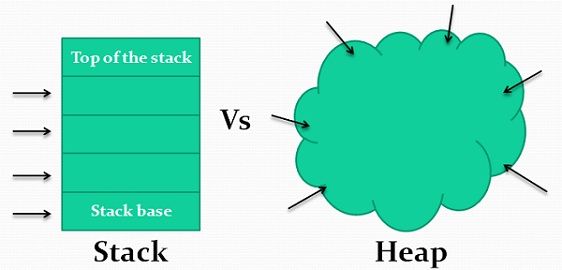
Java Heap Vs Stack: Key Differences Every Developer Should Know in 2021
Java virtual machine (JVM) allocates some part of the memory from the operating system. This memory is later used for creating objects as well as instances, and this memory is named Java heap. It is used as dynamic memory allocation. It is usually located at the bottom of the address, while garbage is collected once the heap size becomes full. The local variables are stored and method invocations are available in the specific memory named Stack. Stack memory works on the Last-In-First-Out (LIFO) approach. A stack is mentioned as static memory allocation. The size of the memory stack is less in comparison to the heap memory size. To further discuss the Java Heap Vs Stack it is important to understand some essential points for advanced application development.
Key Points Related to Stack Memory
- It’s a temporary memory allocation where the data members can be accessed only if the method( ) containing them is running.
- It simply allocates or de-allocates the memory by default as soon as the corresponding method finishes its execution.
- The corresponding error Java.lang.StackOverFlowError is triggered by JVM, if the stack memory is completely filled.
- Stack memory is considered safe in comparison to the heap memory allocation because the data stored is accessed by owner thread.
- Memory allocation and de-allocation is faster in comparison to the Heap-memory allocation.
- Stack-memory has minimum storage space in comparison to the Heap-memory.
Key Points Related to Heap Memory
- Error message is received by JVM if Heap-space is completely full, java.lang.OutOfMemoryError.
- This memory allocation approach is different from the Stack-space allocation, here no default de-allocation feature is available. We have to implement Garbage collector to clear the old unused objects to use the memory in an efficient manner.
- The processing time of this memory is slow in comparison to the Stack-memory.
- Heap-memory is not threaded-safe like the Stack-memory because data stored in Heap-memory is easily seen by all threads.
- Size of the Heap-memory is quite large in comparison to the Stack-memory.
- Heap-memory is easily accessible or exists as long as the whole Java application runs.
Key Difference between Java Heap Vs Stack
The important points mentioned below are crucial for Java development services to make a smart selection between the two memory allocation processes.
- Java Heap is the part of memory in which elements are stored and removed in any order. In Stack, the elements are stored and removed with Last in First out (LIFO) implementation.
- When Java Heap is completely occupied, it triggers memory error or Java heap space error. While stack memory is occupied, it displays a stack overflow error.
- For Java Heap, Xms, and Xmx Java virtual machine option is used to define the start size and maximum size. On the other hand, in Java Stack, Xss JVM is majorly used to define the size of stack memory.
- When the new object has been created, it simply gets stored in Java heap memory. The reference of the new object has been stored in stack memory.
- Java heap is used when a user does not have any idea regarding the amount of data needed at runtime. A stack is used when a user knows actually the amount of data needed before the compile time.
- In a heap, no dependency is required on any element to access other elements. Any element is randomly accessed at any time. While in Stack, there is a specific order to access the element.
- Heap is highly complex as it cannot justify whether memory gets occupied or free. Alternatively, in a stack, it is simple and easy to mention.
Wrapping Up:
Java Heap and Stack both are important parts of memory management. It plays a vital role while designing and deploying the web application. The knowledge of memory management is essential for an individual before going to run on the live projects. This makes a web or mobile application faster and easy to manage.
The stack is really crucial in exception handling and execution of threads. The values of the stack usually exist within the scope of methods or functions in which they are developed. If that function returns any value, the block of the stack is removed. You can hire Java developer to make optimum use of the memory allocation process as well as stores local variables on the stack. The key difference between Java heap and stack is about the life cycle of the values showing how variables are allocated to memory and disposed of for a specific web application.
Frequently Asked Questions
1. Does heap have more memory than Stack?
Size of Heap-memory is quite larger as compared to the Stack-memory. Heap-memory is accessible or exists as long as the whole application (or java program) runs.
2. What is stored in Stack memory in Java?
Stack Memory in Java is used for static memory allocation and the execution of a thread. It contains primitive values that are specific to a method and references to objects that are in a heap, referred from the method. Access to this memory is in Last-In-First-Out (LIFO) order.
3. Is heap faster than stack?
The data is added and removed in a last-in-first-out manner, stack-based memory allocation is very simple and typically much faster than heap-based memory allocation (also known as dynamic memory allocation) typically allocated via malloc.
4. What is structure of Java heap?
A heap is a special data structure in Java. A heap is a tree-based data structure and can be classified as a complete binary tree. All the nodes of the heap are arranged in a specific order.

